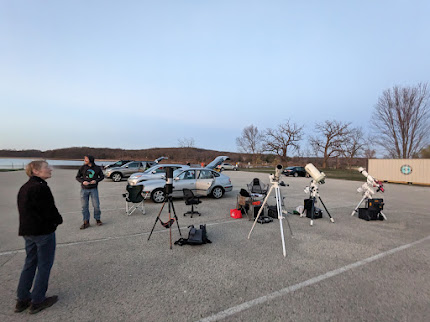Starting to cruise the clear skies this week: M105, the other Leo trio, and more.
We're just getting started on a stretch of clear sky this week + excellent temps, so what more could you ask for? Well, sleep - it's going to be a rough work week to also get through, but enjoy the stars while you can!
As we work to bring Electronically Assisted Astronomy (EAA) options to the Milwaukee Astronomical Society, to allow minimal post-processing to get photos of deep sky objects like these, I wanted to mark a few cool objects I was able to observe using the Unistellar eVscope which live stacks my images as we look at them, and essentially gives me a photo output in just a few minutes using no further image processing, which I'll share below. This scope will be making a lot of trips out to the club this year once again, and many got to experience c/2022 e3 with this scope during winter while huddled inside where it was warm!
I took these photos in my backyard, in Milwaukee, under Bortle 8 skies, which are brighter skies than at the MAS so it's an example of how urban astronomy is very possible. I'm hoping it will be clear on Monday the 17th after our membership meeting at UWM this month, so you can join me on the rooftop of the UWM physics building to see more sites like this through this scope, as well as their Celestron c14.
The first object we're looking at is NOT the famous Leo Triplet, but rather, the "other Leo Triplet" and part of what's called the Leo 1 group. M105 is located on the bottom right, then NGC 3384 on the top, with NGC 3389 over on the left. NGC 3384 is magnitude 10, and is 35 million light-years away in the constellation of Leo the lion. M105 is an elliptical galaxy 36.6 million light years away and one of the biggest elliptical galaxies in the Messier catalogue, containing a gigantic supermassive black hole at the center. Finally on the left we have NGC 3389, which is a spiral galaxy greater than 60 million light years away and not actually a part of this galaxy cluster. But, it still looks pretty neat - I did cheat a little bit and did a minor amount of post processing by stacking 5 "micro-stacks" of the eVscope outputs to form a mega image if you will, below, with just a touch of processing applied:
Now we have the familiar Hercules cluster, and the largest globular cluster in the northern hemisphere sky. It is also very close in comparison to the above, in our own galaxy at 21,000 light years away. It has the luminosity of a quarter million suns, and a true diameter spanning over 140 light years. This one will be a favorite to catch from the club all spring and summer. All photos below are pure EAA shots, no post-processing:
Then we're going back out again to NGC 6166 on the left of the screen, with Abell 2199 closer to the center, which is nearby and part of the Hercules Supercluster with some faint companion galaxies revealing themselves last night after a few minutes, under no moon even in an urban setting that I'm in. This is a supergiant elliptical system that is way out there again at 490 million light years. We're seeing a lot of other faint fuzzy galaxies in this shot, which should be expected given our conditions:
Now on to other clusters, we have an old open cluster of NGC 2355, in the constellation Gemini. Typically open clusters near us that we can see are not old, but this one is about a billion years old, and just 5,400 light years away!
Enjoy! And share what you spot in the sky this week in this perfect, albeit a little breezy, weather we've got!





Comments
Post a Comment